
How to build an Anti-Phishing solution to Secure a Digital Environment
Phishing remains one of the most widespread attack vectors on the Internet. Cybercriminals continuously register look‑alike phishing sites, hide behind anonymity services, spin up malicious sub‑domains, and spoof legitimate certificates to lure victims into divulging credentials or installing malware. For security teams and even general tech users, staying ahead of this dynamic threat landscape requires a combination of domain intelligence, continuous monitoring and fast response. WhoisFreaks an extensive platform offering domain‑related APIs, data feeds and monitoring services provides the building blocks needed to build a robust anti‑phishing solution.
This guide explores how phishing campaigns work, then shows how to combine WhoisFreaks' tools to detect suspicious domain registrations, verify SSL certificates, identify malicious IPs, track brand misuse and automate proactive defenses. Whether you are a cybersecurity professional looking to enrich threat intelligence or a general tech reader wanting to protect a digital brand, the article will help you build an anti‑phishing strategy using real‑time data, automated monitoring, and anti-phishing tools.
Understanding the Phishing Lifecycle
Phishing attacks generally follow a predictable lifecycle:
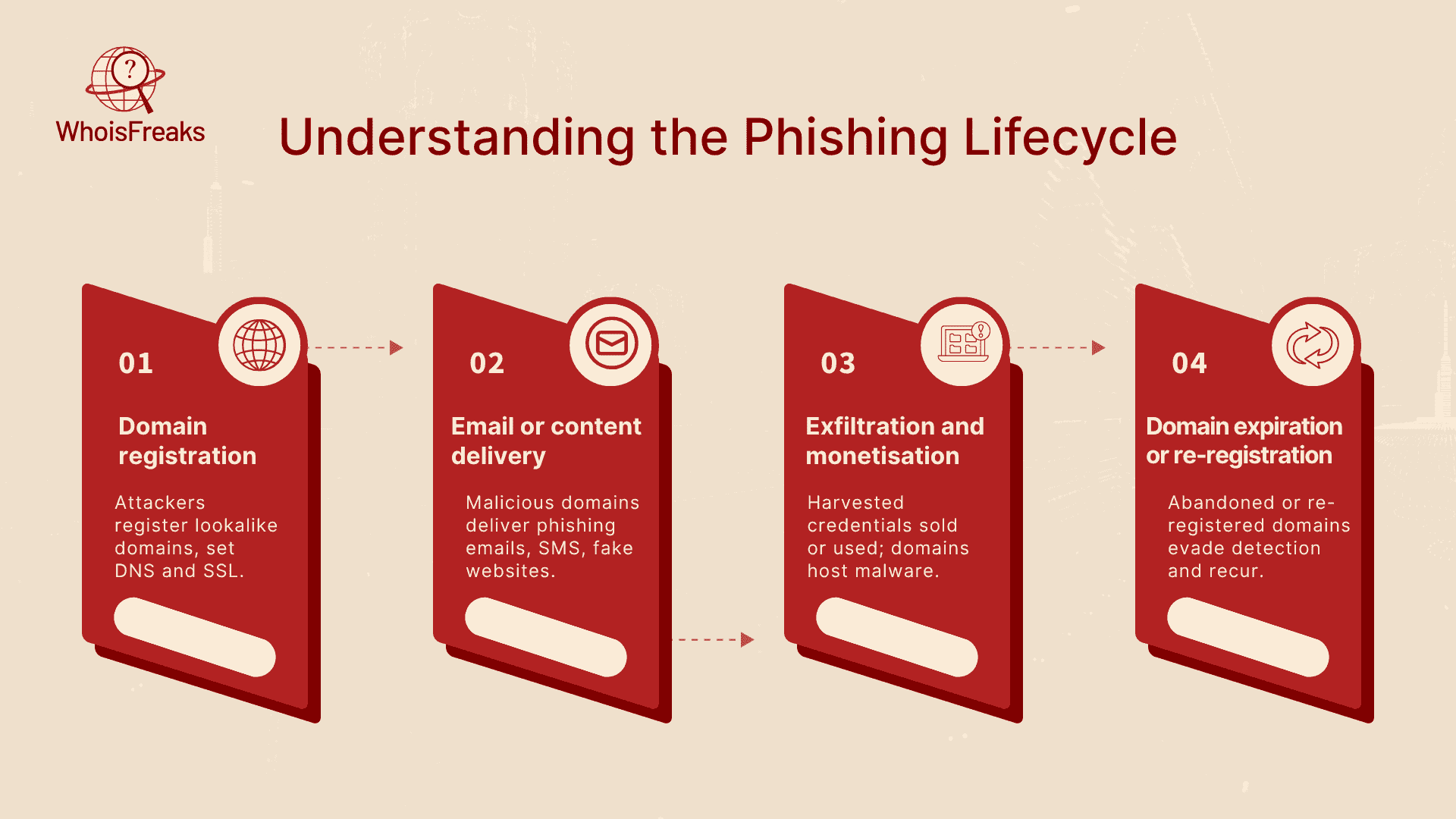
- Domain registration and infrastructure setup. Attackers register domains that resemble legitimate brands or use typos to trick users. They configure DNS records, sub‑domains and SSL certificates to mimic the target.
- Email or content delivery. The malicious domain is used in phishing emails, SMS messages or fake websites that request credentials or payment details.
- Exfiltration and monetisation. Collected credentials are harvested or sold on the dark web. Sometimes the compromised domain is re‑used to host malware or serve as a command and control server.
- Domain expiration or re‑registration. Attackers often abandon domains after a short period to evade detection, or they re‑register them for repeated campaigns.
Why Domain Intelligence Matters
Traditional anti‑phishing measures, such as spam filters or URL block lists, often react after a campaign has caused damage. Domain intelligence provides the context behind a domain: who owns it, when it was registered, where its nameservers and IP addresses reside, whether it uses privacy services or appears on blacklists. Combining these signals reveals patterns that are hard to fake. For example, if a domain claiming to represent a global bank was registered only yesterday using a privacy proxy in an unrelated country, its legitimacy is questionable due to the tactics often employed in social engineering . Real‑time data about newly registered domains, sub‑domain enumeration, SSL certificate chains and IP geolocation can expose malicious infrastructure before phishing emails are sent.
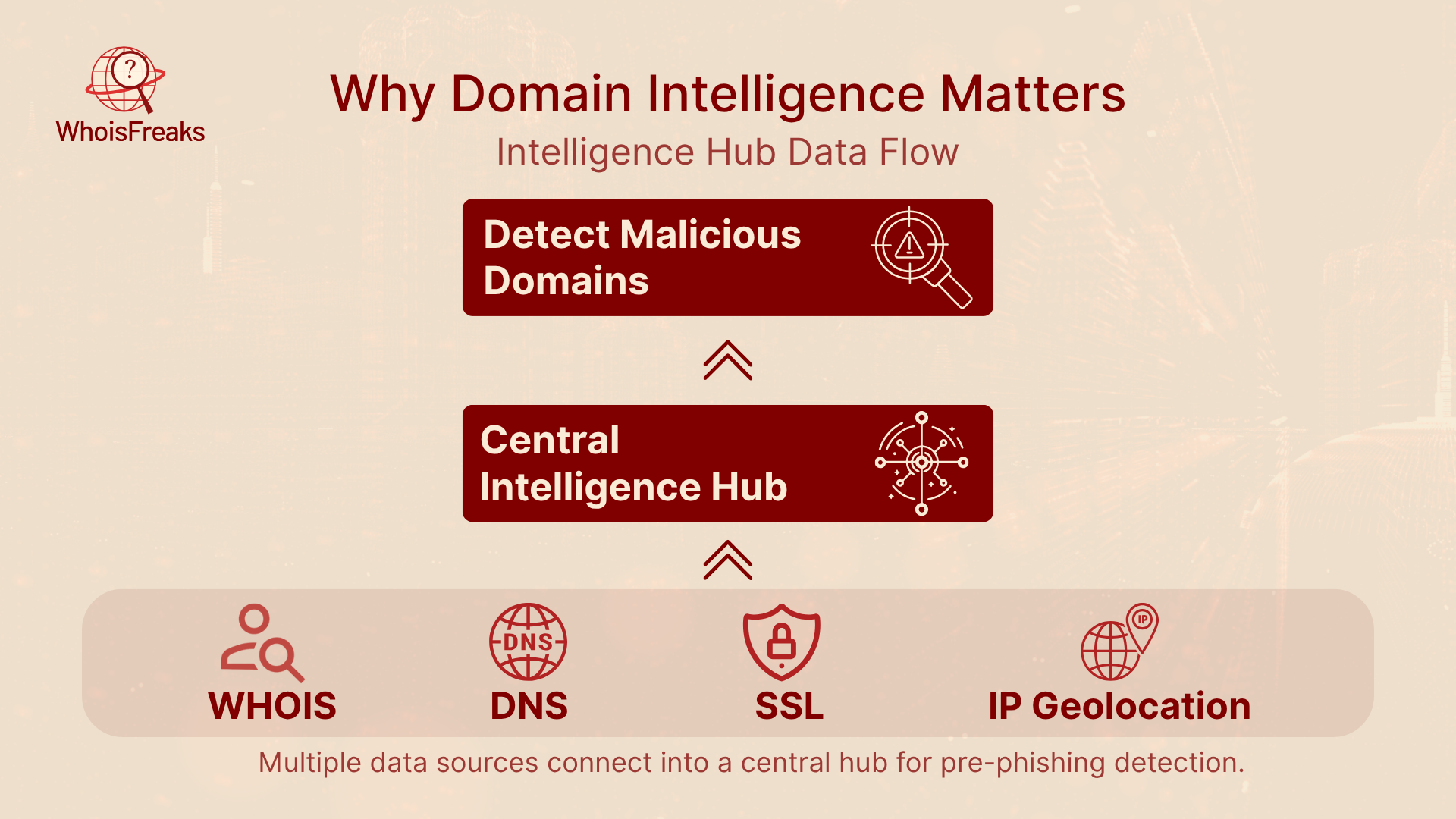
Overview of WhoisFreaks Tools
WhoisFreaks offers a diverse set of API solutions, data feeds and monitoring services. The home page lists several APIs for domain intelligence, DNS records, IP geolocation, SSL information and threat lookup, alongside data feeds such as newly registered domains and monitoring services for domains, brands and registrants. These capabilities span the entire domain lifecycle, enabling proactive detection and continuous surveillance, making it one of the best anti phishing solutions available. Key solutions relevant to anti‑phishing include:
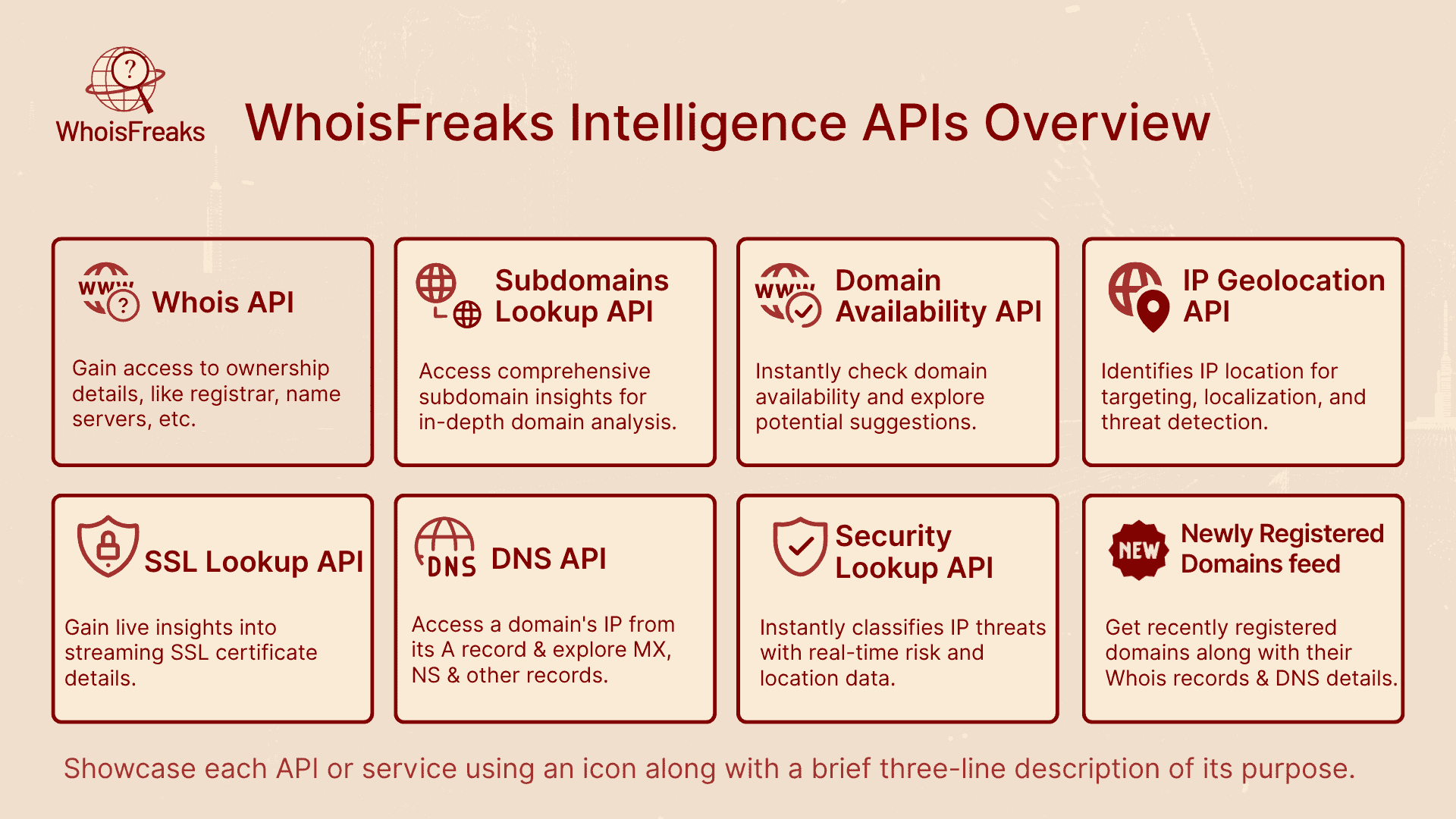
- Whois API: Provides real‑time and historical WHOIS data, reverse look‑ups by owner, email, company, or keywords, and bulk domain queries. Useful for verifying domain ownership and identifying suspicious registrants.
- Subdomains Lookup API: Enumerates all known sub‑domains of a domain, including timestamps for first and last seen, aiding attack surface mapping and misconfiguration detection.
- Domain Availability API: Checks whether domains are available and offers suggestions; beneficial for defensive registration and brand protection.
- SSL Lookup API: Retrieves full SSL certificate chains with expiry dates, issuers and encryption details. Helps verify whether a site uses a legitimate or self‑signed certificate.
- DNS API: Provides real‑time DNS record retrieval across types such as A, AAAA, MX, NS, SOA, SPF, TXT and CNAME, enabling live DNS checks.
- Security Lookup API: Detects VPNs, proxies, Tor and bot activity, calculates threat scores and provides AS number and organization details. Crucial for identifying malicious IP addresses.
- IP Geolocation API: Pinpoints IP locations to city level, supplies country metadata and network details such as ASN and connection types. Also offers fraud scoring use cases.
- Newly Registered Domains feed: A daily updated database containing recently registered domains with WHOIS and DNS records across gTLD and ccTLD zones. Useful for early detection of new suspicious domains.
With these tools focused on email security, defenders can automate data collection and detection across the phishing lifecycle. The following sections map each stage of an anti‑phishing solution to specific WhoisFreaks capabilities.
Step-by-Step Anti-Phishing Strategy Using WhoisFreaks
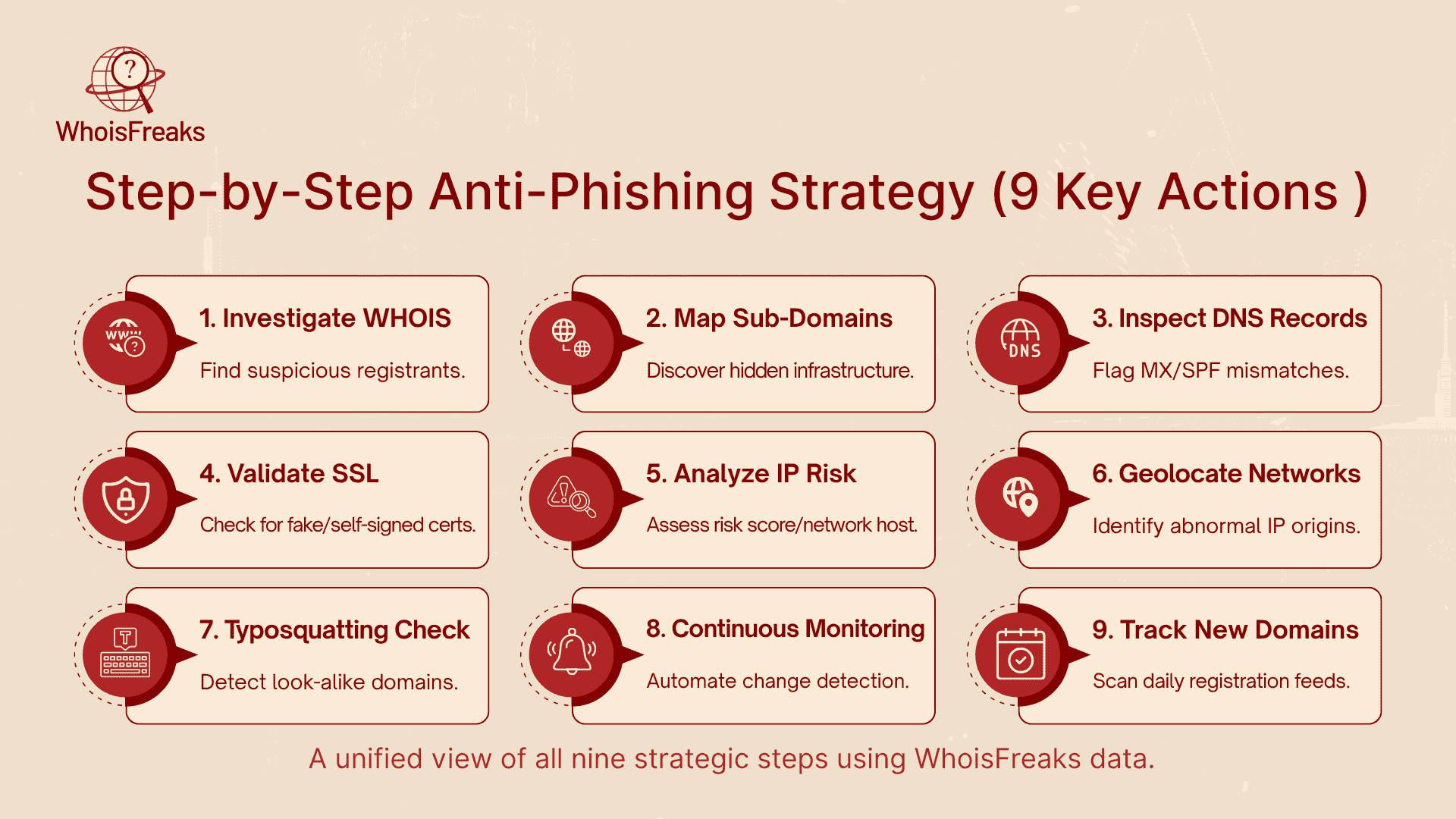
1. Investigate Domains with WHOIS Lookup
Every anti-phishing process begins by validating suspicious domains found in emails, logs, or alerts. The WHOIS Lookup API from WhoisFreaks helps uncover a domain’s true identity by providing real-time registration data, historical ownership records, and reverse lookups that reveal related domains controlled by the same entity and might be used to reveal personal information.
How it helps:
- Access complete domain ownership details, registrar information, and creation dates.
- Compare historical WHOIS records to detect recent ownership changes or re-registrations.
- Use Reverse WHOIS to find other domains registered by the same name, email, or organization.
- Analyze multiple domains simultaneously through bulk lookup for faster investigations.
Example: If your company receives a link to screenshotapi.net, a WHOIS check might show it was registered just yesterday under a privacy proxy an instant red flag signaling a possible phishing attempt.
2. Map Sub-Domains and Hidden Infrastructure
Phishing actors often create multiple sub-domains to host login pages, fake portals, or malware. Identifying these sub-domains reveals the attacker’s entire infrastructure. The Subdomains Lookup API from WhoisFreaks provides an extensive list of all sub-domains associated with a parent domain, along with their discovery timelines.
How it helps:
- Enumerates all known sub-domains tied to a suspicious domain.
- Displays first-seen and last-seen timestamps to track activity.
- Highlights sudden spikes in sub-domain creation that may indicate phishing campaigns.
Example: A query for screenshotapi.net may uncover login.screenshotapi.net and cdn.screenshotapi.net, both registered recently. Such patterns confirm the existence of a coordinated phishing setup.
3. Inspect DNS Records for Anomalies
DNS misconfigurations often expose fraudulent domains. The DNS Lookup API lets you retrieve and inspect A, MX, SPF, TXT, and CNAME records to ensure they match legitimate configurations.
How it helps:
- Identify missing or mismatched SPF records that could enable email spoofing.
- Verify if the domain’s IP or mail servers align with the official organization.
- Combine with Security Lookup API to cross-reference whether linked IPs have a malicious history.
Example: If the MX record points to an unrelated mail server, or the SPF record is missing, it’s a strong sign that the domain is being used for phishing.
4. Validate SSL Certificates
Attackers often use short-term or free SSL certificates to make their fake sites look trustworthy. With the SSL Lookup API, analysts can review complete certificate chains, issuers, and expiry dates to validate a domain’s authenticity.
How it helps:
- Fetch the full certificate chain and verify the issuing authority.
- Detect self-signed or unknown issuers that indicate fake certificates.
- Check certificate validity periods short-term or recently issued ones are suspicious.
Example: If login.screenshotapi.net has a 90-day certificate from an unrecognized authority, it likely isn’t the real bank website.
5. Analyze IP Reputation with Threat Intelligence
Even if the domain looks legitimate, the IP behind it might not be. The Security Lookup API identifies whether an IP address is linked to risky networks such as VPNs, proxies, Tor nodes, or botnets.
How it helps:
- Flags anonymizers and cloud hosting used to hide attacker locations.
- Provides a threat score indicating the IP’s overall risk level.
- Includes ASN and organization data to trace malicious hosting services.
- Supports bulk IP lookups for large-scale analysis.
Example: If an IP scores 90/100 in threat rating and belongs to a known proxy network, blocking it can prevent future phishing activity.
6. Geolocate and Profile Networks
The IP Geolocation API gives context to network activity by mapping IP addresses to their physical locations. Geolocation mismatches often expose fraudulent access attempts.
How it helps:
- Pinpoints the city, region, and country of an IP address.
- Provides ASN and organization details to identify risky networks.
- Enables detection of abnormal patterns, like user logins from foreign regions.
- Allows bulk lookups for faster correlation.
Example: If a user’s account shows multiple failed logins from Eastern Europe while the user resides in the US, geolocation data can confirm suspicious behavior.
7. Prevent Typosquatting with Domain Availability Checks
Phishers frequently register look-alike domains to deceive users. WhoisFreaks' Domain Availability API helps organizations find and register such typo-variants before criminals can use them to trick users via suspicious emails.
How it helps:
- Checks the availability of multiple domain names in bulk.
- Suggests similar or typo-based variations for proactive registration.
- Integrates easily into domain management systems for automated protection.
8. Continuously Monitor Domains, Brands, and Registrants
Phishing threats change daily, making continuous monitoring essential. WhoisFreaks offers three key monitoring tools Domain Monitoring, Brand Monitoring, and Registrant Monitoring to help detect risks early.
How it helps:
- Domain Monitoring: Alerts you to ownership, nameserver, or expiration changes.
- Brand Monitoring: Sends daily notifications for new domains containing your brand or keywords.
- Registrant Monitoring: Tracks domains linked to suspicious registrants or threat actors.
These tools help you act quickly if a domain is hijacked, if someone registers a similar brand domain, or if known attackers appear in your monitoring results.
9. Track Newly Registered Domains and Emerging Threats
Early detection is key to identifying and mitigating interactions with known phishing sites. The Newly Registered Domains Feed provides a daily updated list of new domain registrations worldwide, allowing organizations to identify suspicious names before they’re weaponized.
How it helps:
- Offers daily updated lists of recently registered domains with WHOIS and DNS data.
- Enables brand keyword filtering to catch potential phishing domains early.
- Includes different tiers (with or without cleaned WHOIS or DNS records) for customized monitoring.
Example: Searching the feed for domains containing "acmewidgets" can reveal typosquatting attempts, letting your team block or report them immediately.
Benefits for Cybersecurity Professionals
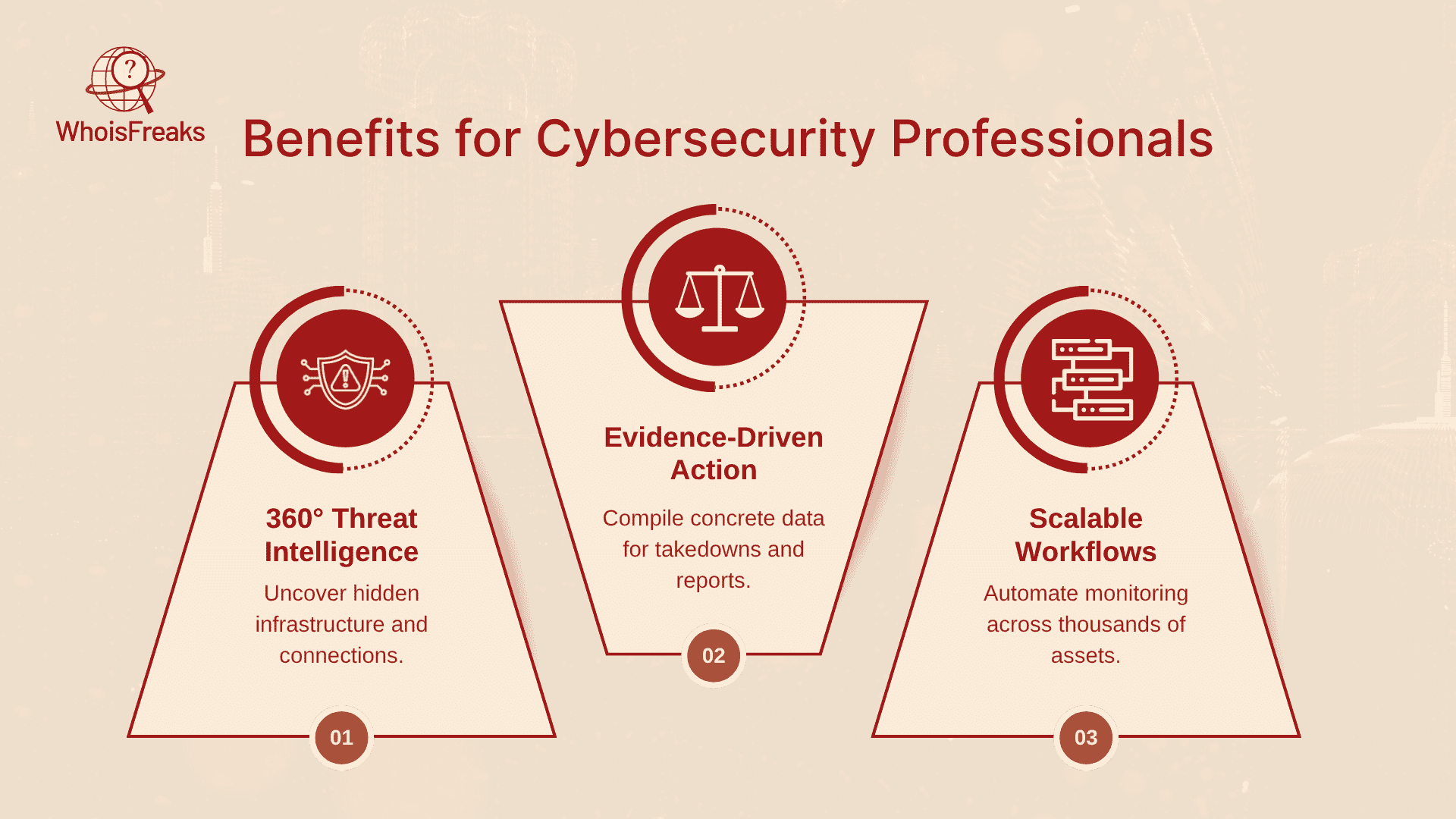
- Comprehensive threat intelligence: The combination of WHOIS, DNS, SSL, IP threat scoring and geolocation provides a 360‑degree view of potential phishing infrastructure.
- Evidence‑driven decisions: Historical WHOIS data and monitor logs supply evidence for legal action against domain hijackers or phishers.
- Scalability: Bulk lookup capabilities across APIs allow analysts to process thousands of indicators quickly.
- Automation ready: JSON output and API endpoints integrate easily into existing security stacks, enabling automated responses.
Conclusion
Phishing is one of the biggest threats to any digital environment. To protect against it, organizations need more than just basic security tools they need accurate domain and IP intelligence.
WhoisFreaks provides complete visibility through its WHOIS Lookup, Reverse WHOIS, Subdomains Lookup, DNS and SSL APIs, IP Geolocation, and Security Intelligence tools. These features help detect fake domains, track suspicious IPs, and monitor brand misuse in real time.
By using WhoisFreaks, security teams can identify phishing threats early, take action faster, and keep their systems safe from online fraud.
Visit WhoisFreaks.com to explore the APIs and start building your own anti-phishing solution today.
FAQs
1. What is an anti-phishing solution?
An anti-phishing solution is a security system that detects and blocks fake emails, websites, or links designed to steal personal or company information.
2. What happens if you open a phishing email but don't click anything?
Usually nothing happens if you just open it but it's best to delete it immediately and avoid replying or downloading any attachments.
3. What does phishing mean?
Phishing is a cyberattack where scammers trick people into giving away sensitive information like passwords or credit card details.
4. What are anti-phishing techniques?
These are methods used to prevent phishing, such as email filters, domain monitoring, multi-factor authentication, and using tools like WhoisFreaks for domain intelligence.

Software Engineer
A software engineer focused on developing scalable, efficient solutions. Expertise in coding, system optimization, and utilizing advanced technologies for high-performance apps.
Related Posts

Understanding Domain Fronting: Benefits, Risks, an...
Explore the benefits and risks of domain fronting, its applications, and how it impacts online privacy. Read the article for a comprehensive overview.
Published at: Nov 20, 2025

Essential Strategies to Prevent Subdomain Takeover...
Learn how to prevent subdomain takeover with essential strategies and best practices. Protect your online assets—read the full guide now!
Published at: Nov 18, 2025

Understanding Spear Phishing: Key Insights and Pre...
Learn about spear phishing: its types, risks, and effective prevention strategies to safeguard your digital life. Read more to protect yourself today.
Published at: Nov 10, 2025

Understanding Cache Poisoning: Risks and Preventio...
Learn about cache poisoning risks and effective prevention strategies to safeguard your online presence. Read the article to protect your systems toda...
Published at: Nov 5, 2025